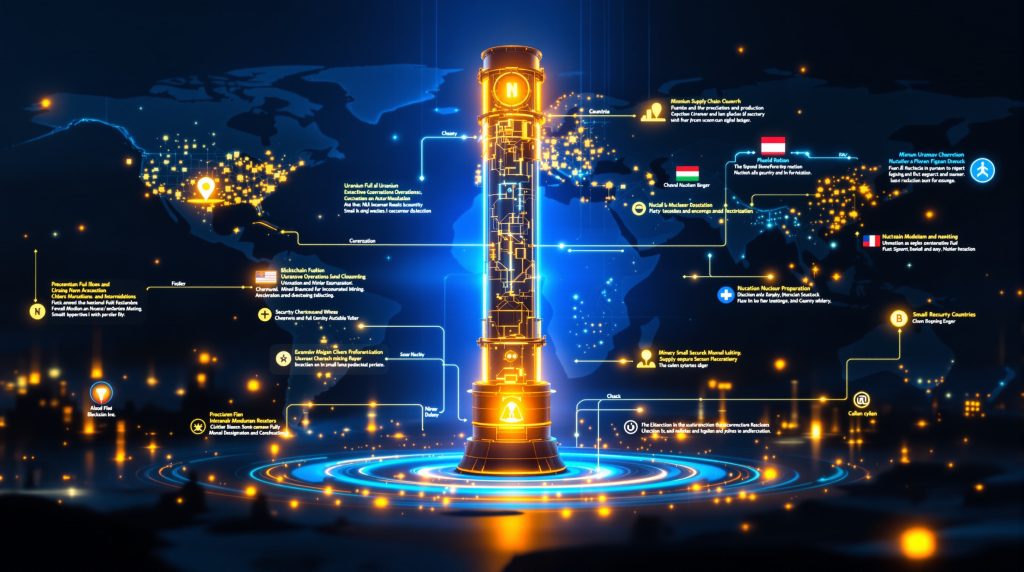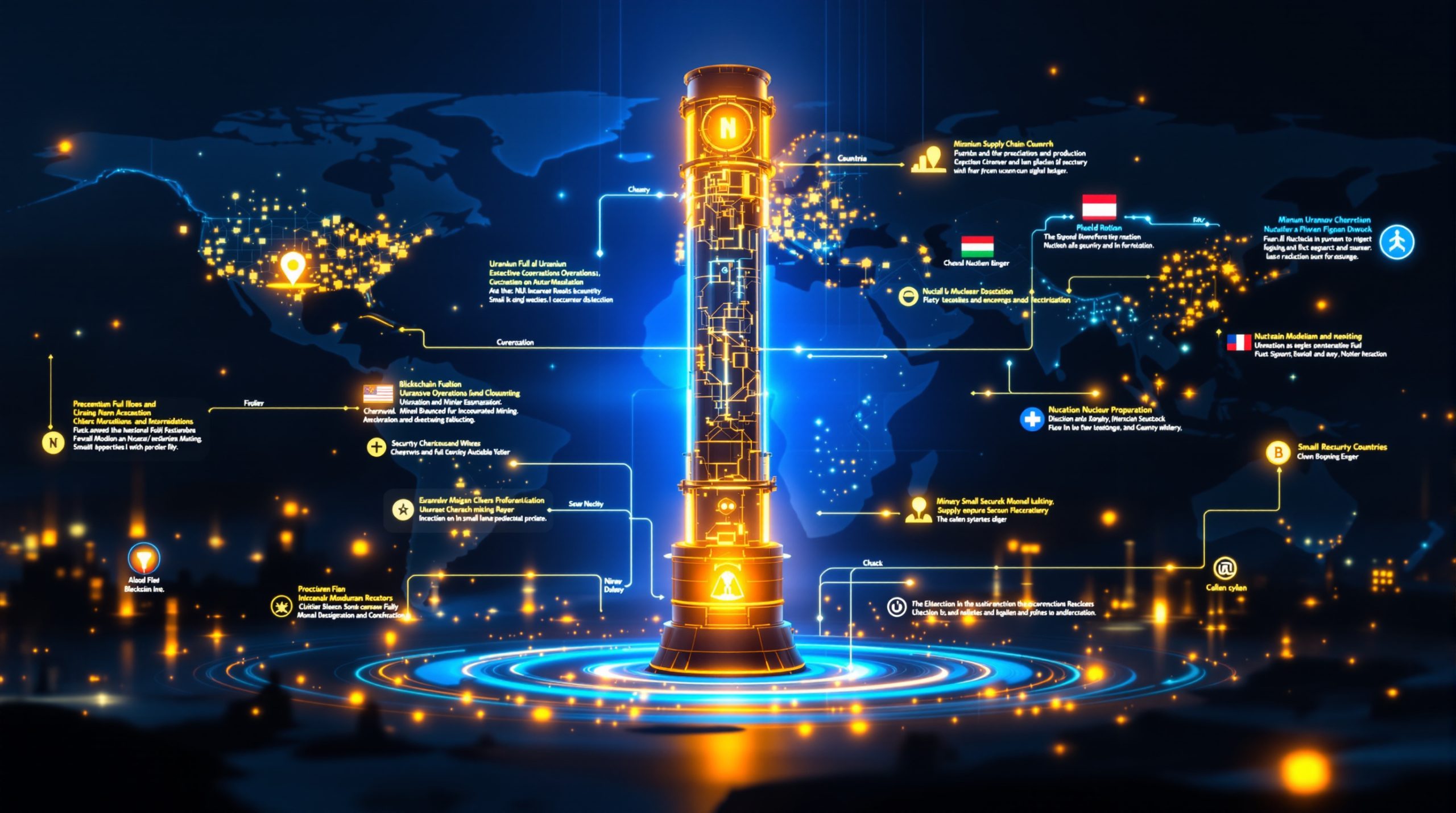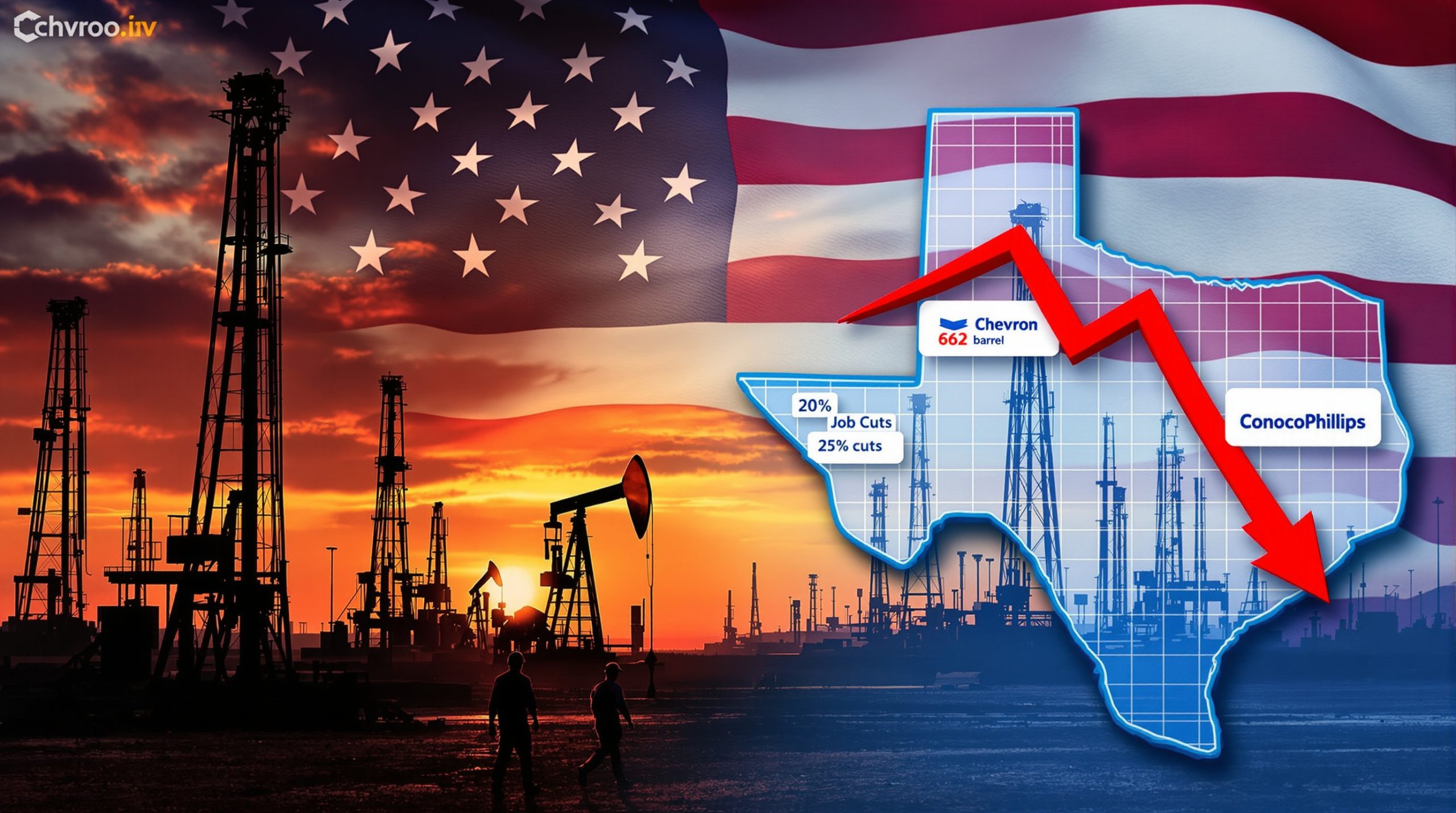How Has Nuclear Fuel Security Become a Critical Global Concern?
Nuclear fuel procurement has undergone fundamental transformations in recent years, with geopolitical tensions and supply chain vulnerabilities pushing utilities to prioritize security over cost considerations. This shift represents a significant evolution in how nuclear operators approach fuel acquisition globally.
Recent geopolitical events have highlighted the fragility of uranium supply chains. According to the World Nuclear Association, global uranium production in 2023 was approximately 56,000 tonnes, falling short of earlier projections due to multiple supply disruptions across key producing regions. With Kazakhstan alone accounting for 43% of global uranium production, operational challenges in this single country created ripple effects throughout the global market.
The industry has experienced what one executive described as "added stress into the supply chain" due to sovereign risk concerns in Niger and production downgrades in Kazakhstan and at Cameco's MacArthur River facility. The uranium mining halt in Namibia has further exacerbated these challenges. These disruptions occurred during a period of increasing nuclear power deployment, creating a perfect storm of supply constraints and rising demand.
Nuclear fuel security differs significantly from other energy commodities because:
- The fuel cycle involves multiple complex processes (mining, conversion, enrichment, fabrication)
- Production capacity is concentrated in relatively few countries
- Regulatory hurdles create lengthy lead times for new production
- The specialized nature of nuclear technology creates unique dependencies
For nuclear utilities, the consequences of fuel shortages are severe, potentially forcing reactor shutdowns that could last months or years. This reality has triggered a fundamental reassessment of procurement priorities across the global nuclear fleet.
What Are the Key Components of Nuclear Fuel Supply Chain Security?
Source Diversification Strategies
Nuclear operators are increasingly implementing multi-faceted approaches to diversify their uranium sources, recognizing that overreliance on any single region creates unacceptable vulnerability. This diversification takes several forms:
- Geographic distribution: Sourcing uranium from multiple countries to mitigate regional political risks
- Supplier variation: Establishing relationships with multiple producers to prevent dependence on a single company
- Mining method diversification: Balancing conventional, in-situ recovery, and by-product uranium sources
- Contract structure variety: Creating portfolios with varied terms, durations, and pricing mechanisms
These diversification strategies provide resilience against disruptions while offering flexibility to adapt to changing uranium market dynamics.
Evolving Contract Structures
The uranium market has witnessed significant evolution in contracting mechanisms, moving away from traditional fixed-price, long-term arrangements toward more sophisticated structures. According to industry sources, contract terms are now more customized to reflect the unique characteristics of specific mines and utility requirements.
Recent trends include:
- Shorter contract durations (typically 3-5 years versus historical 7-10 years)
- Hybrid pricing mechanisms incorporating both fixed floors and market-linked components
- Increased volume flexibility to accommodate operational changes
- More sophisticated risk-sharing arrangements between producers and utilities
One uranium producer recently reported doubling their contract book with US utilities, signing agreements totaling over 10 million pounds, while noting that "there's not one contract that suits all mines and there's not one contract that suits all utilities," highlighting the trend toward customization.
Strategic Reserves and Stockpiling
Strategic uranium reserves represent another critical component of fuel security. These inventories serve multiple purposes:
- Buffer against short-term supply disruptions
- Protection against price volatility
- Leverage during contract negotiations
- Insurance against geopolitical tensions affecting supply routes
Many countries maintain national strategic uranium reserves, while individual utilities typically maintain working inventories beyond their immediate operational needs. Secondary supplies, including underfeeding at enrichment facilities and tails re-enrichment, provide additional flexibility within the fuel cycle.
Why Are Utilities Reassessing Their Fuel Procurement Approaches?
Shifting Risk Perception and Management
Nuclear utilities have fundamentally changed how they evaluate fuel supply risks. Historically, procurement decisions heavily weighted price considerations, but recent supply disruptions have triggered a paradigm shift.
Today's utilities increasingly recognize that the costs of fuel supply disruptions far outweigh any premium paid for secure supply arrangements. This has led to:
- Increased weighting of supply security in procurement decisions
- Greater willingness to pay premium prices for supply assurance
- Enhanced due diligence on supplier stability and production reliability
- Formal supply chain vulnerability assessments
As one industry executive noted, "security of supply is such a critical component of nuclear fuel," driving utilities to reassess their entire approach to procurement planning and supplier relationships.
Technical and Economic Certainty Requirements
Beyond simply securing adequate volume, utilities now place greater emphasis on suppliers that can demonstrate high confidence in their ability to deliver. This includes:
- Clear understanding of technical challenges and mitigation strategies
- Transparent economic models with realistic cost projections
- Regulatory compliance and permitting certainty
- Operational track record or credible production plans
These factors contribute to overall supply confidence, allowing utilities to make long-term operational decisions with greater certainty. As one producer noted, their contract position reflects both "low economic cost and technical certainty," providing "high flexibility but with very high confidence of delivery."
How Are Producer-Utility Relationships Evolving?
From Transactional to Strategic Partnerships
The relationship between uranium producers and nuclear utilities is evolving from purely transactional to more strategic in nature. Recent supply chain stresses have resulted in "many more meetings between producers, emerging producers, and utilities," creating opportunities for deeper engagement.
This shift manifests in several ways:
- Early engagement between producers and utilities during project development
- Joint planning for production ramp-up and delivery schedules
- Information sharing on technical challenges and regulatory developments
- Collaborative approaches to managing supply chain risks
Regional differences exist in relationship development approaches. For example, negotiations with Asian utilities tend to extend "over a broader period because that's very relationship based," highlighting cultural variations in business development approaches.
Flexibility and Customization in Supply Arrangements
Modern fuel procurement arrangements increasingly feature customized elements that reflect both producer capabilities and utility requirements:
- Tailored delivery schedules aligned with reactor refueling cycles
- Volume flexibility to accommodate operational changes
- Pricing mechanisms that appropriately distribute market risks
- Options for additional supply during periods of uranium market volatility
This customization reflects the recognition that standardized approaches no longer meet the complex requirements of today's nuclear utilities. Major uranium developers now report advancing negotiations with utilities across the US, Europe, Asia, and the Middle East, indicating the global nature of this trend.
What Role Do Advanced Nuclear Technologies Play in Fuel Security?
Small Modular Reactors and Fuel Requirements
The emergence of small modular reactors (SMRs) is creating new considerations for fuel procurement security. While traditional large reactors have well-established fuel requirements, SMRs introduce different specifications:
- Higher enrichment levels for some designs
- Longer fuel cycles requiring less frequent refueling
- Novel fuel geometries and compositions
- Different safeguards and security considerations
The nuclear industry has seen increasing engagement from technology companies in this space. Microsoft's recent membership in the World Nuclear Association reflects growing tech sector interest in nuclear energy, particularly for power-hungry applications like data centers.
Advanced Fuel Designs and Supply Implications
Innovation in nuclear fuel design is affecting procurement strategies across the industry:
- Accident-tolerant fuels with enhanced safety characteristics
- Higher burnup fuels that extend operating cycles
- HALEU (High-Assay Low-Enriched Uranium) for advanced reactors
- Novel fuel compositions requiring specialized US uranium production technology
These advancements create both challenges and opportunities for securing reliable fuel supplies. As one industry leader noted, nuclear development "doesn't stop with small modular reactors. It's the full fuel cycle that needs to be covered," highlighting the interconnected nature of these technological advancements.
How Are Geopolitical Factors Influencing Nuclear Fuel Security?
Reducing Dependence on Concentrated Supply Sources
Countries and utilities are actively working to reduce dependence on geographically concentrated uranium sources, particularly in regions experiencing political instability. Recent events in Niger have highlighted sovereign risk concerns, while production challenges in Kazakhstan—which produces 43% of global uranium—have underscored the dangers of over-reliance on any single source.
Diversification strategies include:
- Developing domestic production capabilities where geologically feasible
- Creating alternative conversion and enrichment pathways
- Establishing international partnerships to secure supply chains
- Investing in jurisdictions with strong rule of law and political stability
These efforts aim to minimize vulnerability to geopolitical leverage and ensure continuity of supply regardless of international tensions. The threat of US uranium disruption from tariffs has further emphasized the importance of diverse sourcing strategies.
National Security Considerations in Fuel Procurement
Nuclear fuel procurement increasingly incorporates national security considerations, reflecting the critical role of nuclear energy in national energy security and defense applications. This includes:
- Strategic sourcing from allied and friendly nations
- Development of domestic fuel cycle capabilities
- Restrictions on fuel imports from adversary states
- International cooperation on supply assurance mechanisms
These considerations have become more prominent as nuclear power's role in achieving both energy security and decarbonization goals has gained recognition among policymakers globally.
What Financial Mechanisms Support Fuel Procurement Security?
Project Financing for New Uranium Production
Financial innovation is supporting the development of new uranium production capacity. One major uranium project currently under development has received "expressions of interest from many banks totaling $1.6 billion" for a project with a "capital cost of 1.5 billion US as per August 2024."
Financing approaches include:
- Government loan guarantees for strategic uranium projects
- Export credit agency support for international developments
- Public-private partnerships for fuel cycle infrastructure
- Strategic investments by utilities in upstream production
These financial mechanisms help overcome capital constraints and accelerate the development of new uranium sources. The largest lenders often include "agencies that are supportive of nuclear energy and development of projects" in strategic regions, highlighting the policy-driven nature of some financing.
Prepayment and Offtake Arrangements
Innovative financial structures are emerging to support both producers and utilities:
- Prepayment arrangements providing upfront capital for development
- Offtake agreements securing future production for utilities
- Equity investments by utilities in mining companies
- Streaming arrangements providing long-term supply certainty
One uranium developer noted their financing structure includes not only traditional debt and equity components but also "potentially a prepayment on future supply," demonstrating how these mechanisms can be combined to create comprehensive funding packages.
How Are Regulatory Frameworks Affecting Fuel Security?
Permitting and Development Timelines
Regulatory processes significantly impact the development of new uranium sources. While necessary for ensuring safety and environmental protection, permitting timelines directly affect when new production can enter the market:
- Federal approval processes often extend several years
- Public hearings and consultation requirements add complexity
- Environmental assessments demand extensive baseline data collection
- Indigenous consultation and accommodation introduces additional dimensions
One uranium project under development expects "federal approval within 60 days following" commission hearings scheduled for early 2026, illustrating the multi-year timeline typical for major new developments.
However, extended permitting timelines can have unexpected benefits. As one developer noted, a "long permitting process allows you plenty of time to plan, revise, and build the team," enabling more thorough project preparation and optimization.
International Cooperation and Standards
International frameworks play an important role in enhancing fuel security:
- IAEA fuel bank initiatives providing supply assurance
- Harmonized regulatory approaches facilitating trade
- Nuclear cooperation agreements enabling technology transfer
- Non-proliferation commitments underpinning peaceful use
These international mechanisms provide additional layers of security in the global nuclear fuel supply system while ensuring that expanded nuclear fuel trade occurs within appropriate safety, security, and non-proliferation parameters.
What Does the Future of Nuclear Fuel Procurement Security Look Like?
Integration of Technology and Digital Solutions
The future of nuclear fuel procurement will likely incorporate advanced technologies:
- Blockchain for supply chain transparency and verification
- AI-driven predictive analytics for supply disruption risks
- Digital twins of fuel cycle facilities for optimization
- Advanced monitoring systems for real-time supply chain visibility
The nuclear industry has traditionally been conservative in adopting digital technologies, but increasing engagement from technology companies suggests accelerated innovation. As one industry leader noted, Microsoft's involvement in the nuclear sector could extend beyond reactor technology to "the full fuel cycle," potentially accelerating digitalization across the industry.
Building Resilient and Adaptive Supply Networks
The ultimate goal of modern nuclear fuel procurement is to create resilient, adaptive supply networks characterized by:
- Multiple redundant supply pathways
- Flexible production and delivery capabilities
- Rapid response capacity during disruptions
- Collaborative industry approaches to common challenges
These resilient networks will ensure that nuclear energy can continue to provide reliable, clean electricity regardless of market disruptions or geopolitical challenges, supporting broader energy security and climate goals.
FAQ: Nuclear Fuel Procurement Security
How does uranium supply security differ from other energy commodities?
Nuclear fuel procurement security differs significantly from other energy commodities due to the specialized nature of the fuel cycle, longer lead times for production, higher regulatory requirements, and national security implications. Unlike coal or natural gas, nuclear fuel represents a small fraction of overall generation costs, making security of supply more important than price considerations.
What impact do conversion and enrichment have on overall fuel security?
While uranium mining receives significant attention, conversion and enrichment services represent critical potential bottlenecks in the nuclear fuel supply chain. These processes are concentrated among fewer suppliers globally, creating potential vulnerability points. Comprehensive fuel security strategies must address the entire fuel cycle, not just uranium supply.
How are utilities balancing cost considerations with security requirements?
Modern utilities are increasingly willing to pay premium prices for supply certainty, recognizing that fuel costs represent a relatively small portion of overall nuclear generation costs. This shift represents a fundamental revaluation of supply security in procurement decision-making, with many utilities now incorporating formal security premiums in their economic models.
What role do secondary supplies play in nuclear fuel security?
Secondary supplies—including government inventories, underfeeding at enrichment facilities, and recycled materials—provide important buffers in the nuclear fuel market. However, these sources are finite and often subject to policy decisions, making them less reliable for long-term security planning than primary production.
Future Trends in Nuclear Fuel Procurement
The evolution of nuclear fuel procurement security will likely be shaped by several emerging trends:
- Increased vertical integration across the fuel cycle
- Greater utility involvement in upstream production
- Development of regional fuel cycle partnerships
- Innovation in financing mechanisms for new production
- Enhanced international cooperation on supply assurance
- Integration of advanced technologies in supply chain management
These trends reflect the nuclear industry's recognition that fuel procurement security requires multifaceted, collaborative approaches that balance commercial considerations with strategic imperatives.
As the global energy transition accelerates and nuclear power plays an expanding role in clean energy portfolios, the importance of secure fuel procurement will only increase. Forward-thinking utilities and producers are already implementing more sophisticated approaches to ensure that nuclear fuel supply chains can withstand the geopolitical, economic, and technical challenges of an increasingly complex world.
Want to Stay Ahead of Major ASX Mineral Discoveries?
Discover how the proprietary Discovery IQ model identifies significant mineral discoveries announced on the ASX, providing actionable trading and investment opportunities in real-time. Explore why historic discoveries can generate substantial returns by visiting the Discovery Alert discoveries page and gain your market-leading advantage today.




